Leave Crop Residues
Allow the seed heads of flowers such as coneflower and grasses to mature and remain over the winter to feed winter birds, add winter interest, and possibly capture a pretty dusting of snow.
Cut vegetable remains off at the soil line, leaving the roots in the ground. Lay leafy tops right on the soil surface. Chop and compost larger pieces of crop residue. The earthworms and soil microbes will thank you for leaving them undisturbed, with a source of organic matter (the roots) at the ready, so they can continue to aerate the soil and decompose the organic matter, helping prepare the soil for spring planting.
Roots contain carbon, and so leaving roots in the soil also helps capture, or sequester, carbon in the soil. On the other hand, if the roots are pulled and exposed to air, the carbon they contain transforms into carbon dioxide, a greenhouse gas.
Skip the Tilling
Although the result appears to be a nice, smooth surface ready for spring planting, in many cases tilling actually harms the soil. It leaves the soil bare and thus vulnerable to erosion. Bare soil can also blow away, or be compacted from heavy downpours. Tilling breaks apart the soil aggregates, or clumps, that allow water and air to move through the soil to reach plant roots, and annihilates many soil organisms.
Do a Soil Test
Fall is a good time to test your soil nutrient and, perhaps most importantly, pH levels. If’ you’ve been adding lots of compost to the beds each year, you may have sufficient nutrients. But if the pH (soil acidity/alkalinity) is too high or too low, plants may have trouble accessing those nutrients. Your state Cooperative Extension may offer soil test kits, or you can purchase DIY kits. Fall is a good time to add limestone (to “sweeten” soil, or raise its pH) or sulfur (to acidify soil). Fall is also a good time to add slow-release amendments, such as greensand, a source of iron, potassium, and magnesium. Learn more: Preparing the Soil
Add Organic Matter
In many parts of the country, fall is a free-for-all for organic matter, as people rake up leaves and cart them off to their local composting facility (and hopefully not the landfill). Little do they know they are tossing away a valuable source of nutrients for their gardens and even lawns! In addition to adding compost to garden beds in fall, mix in shredded leaves. Or simply layer leaves on top of the bed, and sprinkle a layer of soil or compost over them to hold them in place.
Cover Your Soil
If you’ve spread leaves and compost, your bed may be well protected from winter winds and downpours. If not, cover the beds with something — anything! — to protect the soil. A layer of straw, large leaves pulled from spent plants, row cover fabric. Nature doesn’t like her soil left bare to the elements, and if you don’t cover it, she will — with weeds.

Cover crop
Plant a Cover Crop
A fabulous way to protect soil is with a winter cover crop. Planted in fall, the seeds sprout and grow roots and shoots. The desired effect, timing of planting, and climate all play roles in choosing the right crop. In northern regions with cold winters, winter rye is a common cover crop. Learn more: Cover Crops
Plan to Rotate Crops
Different crops pull differing amounts and types of nutrients from the soil, and when we harvest those crops, we remove those nutrients from the bed. Although we can strive to replace the nutrients through compost and various amendments, it’s a good idea to create a planting calendar that puts different crops in different beds, ideally on a three-year rotation. That way, root crops can pull nutrients up from deep in the soil, “heavy-feeders” like corn can make way for nitrogen-fixing legumes, and fast-maturing crops open up areas for summer cover crops. (See Growing Guide: Buckwheat Cover Crop) Make maps of each year’s planting plans, so you can ensure a healthy rotation.



